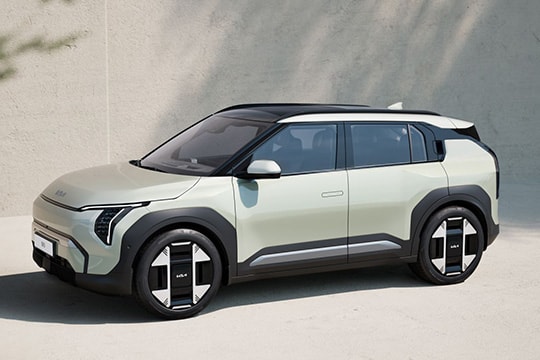KIA EV3 Models/Series Timeline, Specifications & Photos
First production year: 2024
Engines: Electric
Body style: SUV (Sports Utility Vehicle)
Kia introduced the EV3 in the late spring of 2024, competing in a crowded segment of affordable electric vehicles with an EV that could provide an impressive range.
Revealed in 2023 as a concept car, the 2024 EV3 was a significant step in its electrification program. Even though it relied partly on the same platform as the EV6, its underpinnings were based on a 400-volt platform instead of an 800-volt one, as on its more powerful brother. Kia made the EV3 to compete in the affordable compact EV segment with a crossover-like car that could comfortably carry a family of four and their belongings on short or long travels. It was considered a proper replacement for the aging Kia Soul EV, which was already outdated. The Korean automaker successfully managed to integrate some of the ideas seen on the EV9, which gave the compact-sized vehicle an upscale look.
The EV3 sported an almost vertical, flat front fascia dominated by panels, lines, and LED light stripes. Its DRLs created an angular visual delimitation of the car’s width, while the headlights sported eight distinct blocks arranged in two vertical rows. On the lower side, depending on the grade, the automaker added an air intake integrated into the lower part of the bumper, while a lip spoiler adorned the apron’s lowest edge.
With a profile that resembled other SUVs and crossovers, the EV3 had a lower roof than the Soul that it replaced. Its greenhouse sported black trims on the A and B pillars, while the C-posts featured a horizontal line, creating a floating-roof design theme. The angular-shaped wheel arches sported black plastic trims, emphasizing the enlarged fenders and rear quarter panels, giving the car a muscular stance. Furthermore, the sculptured doors and the black side sills emphasized the carmaker’s design philosophy, named “Opposites United” by Kia’s styling department. Finally, at the back, the tailgate featured a raked-forward window and a roof spoiler. Furthermore, it sported a set of red stripes and was flanked by a set of vertical taillights.
Inside, the automaker’s styling team took inspiration from the EV3’s bigger brother, the EV9. The minimalist design of the dashboard looked clean, without unnecessary items on it. It sported a set of three screens. The one fronting the driver was the instrument panel, which had a similar size to the touchscreen for the infotainment system. Between them, a narrow touch-sensitive display was used exclusively for the HVAC system. However, a secondary set of physical buttons placed on the center stack below the vents also controlled the temperature and the fan speed. Kia installed high-mounted seats at the front, separated by a center console that sported an armrest and a retractable panel. Lower, the car manufacturer placed a storage tray, a pair of cup holders, and an induction charging pad for mobile phones. At the same time, in the back, the EV3 featured a 60/40 split-folding bench seat, with enough room for three adult-sized passengers, especially since the floor was completely flat.
At the sales’ start, Kia offered the EV3 with a 204 PS (201 hp) motor that sent its torque to the front wheels only but offered a choice of two battery packs. The entry-level version could be replenished with up to 102 kW charging speed, while the one with an 81.4 kWh battery could accept a 128 kW charging rate.
